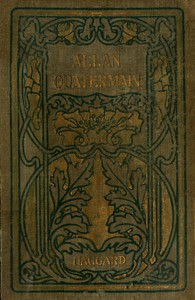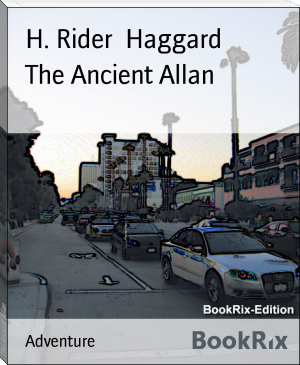Allan Quatermain, H. Rider Haggard [robert munsch read aloud TXT] 📗

- Author: H. Rider Haggard
Book online «Allan Quatermain, H. Rider Haggard [robert munsch read aloud TXT] 📗». Author H. Rider Haggard
As we stood gazing at this splendid sight, of which more anon, there suddenly dashed up to the gateway four chariots, each drawn by two white horses. These chariots are two-wheeled, and made of wood. They are fitted with a stout pole, the weight of which is supported by leathern girths that form a portion of the harness. The wheels are made with four spokes only, are tired with iron, and quite innocent of springs. In the front of the chariot, and immediately over the pole, is a small seat for the driver, railed round to prevent him from being jolted off. Inside the machine itself are three low seats, one at each side, and one with the back to the horses, opposite to which is the door. The whole vehicle is lightly and yet strongly made, and, owing to the grace of the curves, though primitive, not half so ugly as might be expected.
But if the chariots left something to be desired, the horses did not. They were simply splendid, not very large but strongly built, and well ribbed up, with small heads, remarkably large and round hoofs, and a great look of speed and blood. I have often wondered whence this breed, which presents many distinct characteristics, came, but like that of its owners, its history is obscure. Like the people the horses have always been there. The first and last of these chariots were occupied by guards, but the centre two were empty, except for the driver, and to these we were conducted. Alphonse and I got into the first, and Sir Henry, Good, and Umslopogaas into the one behind, and then suddenly off we went. And we did go! Among the Zu-Vendi it is not usual to trot horses either riding or driving, especially when the journey to be made is a short one—they go at full gallop. As soon as we were seated the driver called out, the horses sprang forward, and we were whirled away at a speed sufficient to take one’s breath, and which, till I got accustomed to it, kept me in momentary fear of an upset. As for the wretched Alphonse, he clung with a despairing face to the side of what he called this “devil of a fiacre”, thinking that every moment was his last. Presently it occurred to him to ask where we were going, and I told him that, as far as I could ascertain, we were going to be sacrificed by burning. You should have seen his face as he grasped the side of the vehicle and cried out in his terror.
But the wild-looking charioteer only leant forward over his flying steeds and shouted; and the air, as it went singing past, bore away the sound of Alphonse’s lamentations.
And now before us, in all its marvellous splendour and dazzling loveliness, shone out the Temple of the Sun—the peculiar pride of the Zu-Vendi, to whom it was what Solomon’s, or rather Herod’s, Temple was to the Jews. The wealth, and skill, and labour of generations had been given to the building of this wonderful place, which had been only finally completed within the last fifty years. Nothing was spared that the country could produce, and the result was indeed worthy of the effort, not so much on account of its size—for there are larger fanes in the world—as because of its perfect proportions, the richness and beauty of its materials, and the wonderful workmanship. The building (that stands by itself on a space of some eight acres of garden ground on the hilltop, around which are the dwelling-places of the priests) is built in the shape of a sunflower, with a dome-covered central hall, from which radiate twelve petal-shaped courts, each dedicated to one of the twelve months, and serving as the repositories of statues reared in memory of the illustrious dead. The width of the circle beneath the dome is three hundred feet, the height of the dome is four hundred feet, and the length of the rays is one hundred and fifty feet, and the height of their roofs three hundred feet, so that they run into the central dome exactly as the petals of the sunflower run into the great raised heart. Thus the exact measurement from the centre of the central altar to the extreme point of any one of the rounded rays would be three hundred feet (the width of the circle itself), or a total of six hundred feet from the rounded extremity of one ray or petal to the extremity of the opposite one.[15]
[15] These are internal measurements.—A. Q.
The building itself is of pure and polished white marble, which shows out in marvellous contrast to the red granite of the frowning city, on whose brow it glistens indeed like an imperial diadem upon the forehead of a dusky queen. The outer surface of the dome and of the twelve petal courts is covered entirely with thin sheets of beaten gold; and from the extreme point of the roof of each of these petals a glorious golden form with a trumpet in its hand and widespread wings is figured in the very act of soaring into space. I really must leave whoever reads this to imagine the surpassing beauty of these golden roofs flashing when the sun strikes—flashing like a thousand fires aflame on a mountain of polished marble—so fiercely that the reflection can be clearly seen from the great peaks of the range a hundred miles away.
It is a marvellous sight—this golden flower upborne upon the cool white marble walls, and I doubt if the world can show such another. What makes the whole effect even more gorgeous is that a belt of a hundred and fifty feet around the marble wall of the temple is planted with an indigenous species of sunflower, which were at the time when we first saw them a sheet of golden bloom.
The main entrance to this wonderful place is between the two northernmost of the rays or petal courts, and is protected first by the usual bronze gates, and then by doors made of solid marble, beautifully carved with allegorical subjects and overlaid with gold. When these are passed there is only the thickness of the wall, which is, however, twenty-five feet (for the Zu-Vendi build for all time), and another slight wall also of white marble, introduced in order to avoid causing a visible gap in the inner skin of the wall, and you stand in the circular hall under the great dome. Advancing to the central altar you look upon as beautiful a sight as the imagination of man can conceive. You are in the middle of the holy place, and above you the great white marble dome (for the inner skin, like the outer, is of polished marble throughout) arches away in graceful curves something like that of St Paul’s in London, only at a slighter angle, and from the funnel-like opening at the exact apex a bright beam of light pours down upon the golden altar. At the east and the west are other altars, and other beams of light stab the sacred twilight to the heart. In every direction, “white, mystic, wonderful”, open out the ray-like courts, each pierced through by a single arrow of light that serves to illumine its lofty silence and dimly to reveal the monuments of the dead.[16]
[16] Light was also admitted by sliding shutters under the eaves of the dome and in the roof.—A. Q.
Overcome at so awe-inspiring a sight, the vast loveliness of which thrills the nerves like a glance from beauty’s eyes, you turn to the central golden altar, in the midst of which, though you cannot see it now, there burns a pale but steady flame crowned with curls of faint blue smoke. It is of marble overlaid with pure gold, in shape round like the sun, four feet in height, and thirty-six in circumference. Here also, hinged to the foundations of the altar, are twelve petals of beaten gold. All night and, except at one hour, all day also, these petals are closed over the altar itself exactly as the petals of a water-lily close over the yellow crown in stormy weather; but when the sun at midday pierces through the funnel in the dome and lights upon the golden flower, the petals open and reveal the hidden mystery, only to close again when the ray has passed.
Nor is this all. Standing in semicircles at equal distances from each other on the north and south of the sacred place are ten golden angels, or female winged forms, exquisitely shaped and draped. These figures, which are slightly larger than life-size, stand with bent heads in an attitude of adoration, their faces shadowed by their wings, and are most imposing and of exceeding beauty.
There is but one thing further which calls for description in this altar, which is, that to the east the flooring in front of it is not of pure white marble, as elsewhere throughout the building, but of solid brass, and this is also the case in front of the other two altars.
The eastern and western altars, which are semicircular in shape, and placed against the wall of the building, are much less imposing, and are not enfolded in golden petals. They are, however, also of gold, the sacred fire burns on each, and a golden-winged figure stands on either side of them. Two great golden rays run up the wall behind them, but where the third or middle one should be is an opening in the wall, wide on the outside, but narrow within, like a loophole turned inwards. Through the eastern loophole stream the first beams of the rising sun, and strike right across the circle, touching the folded petals of the great gold flower as they pass till they impinge upon the western altar. In the same way at night the last rays of the sinking sun rest for a while on the eastern altar before they die away into darkness. It is the promise of the dawn to the evening and the evening to the dawn.
With the exception of those three altars and the winged figures about them, the whole space beneath the vast white dome is utterly empty and devoid of ornamentation—a circumstance that to my fancy adds greatly to its splendour.
Such is a brief description of this wonderful and lovely building, to the glories of which, to my mind so much enhanced by their complete simplicity, I only wish I had the power to do justice. But I cannot, so it is useless talking more about it. But when I compare this great work of genius to some of the tawdry buildings and tinsel ornamentation produced in these latter days by European ecclesiastical architects, I feel that even highly civilized art might learn something from the Zu-Vendi masterpieces. I can only say that the exclamation which sprang to my lips as soon as my eyes first became accustomed to the dim light of that glorious building, and its white and curving beauties, perfect and thrilling as those of a naked goddess, grew upon me one by one, was, “Well! a dog would feel religious here.” It is vulgarly put, but perhaps it conveys my meaning more clearly than any polished utterance.
At the temple gates our party was received by a guard of soldiers, who appeared to be under the orders of a priest; and by them we were conducted into one of the ray or “petal” courts, as the priests call them, and there left for at least half-an-hour. Here we conferred together, and realizing that we stood in great danger of our lives, determined, if any attempt should be made upon us, to sell them as dearly





Comments (0)